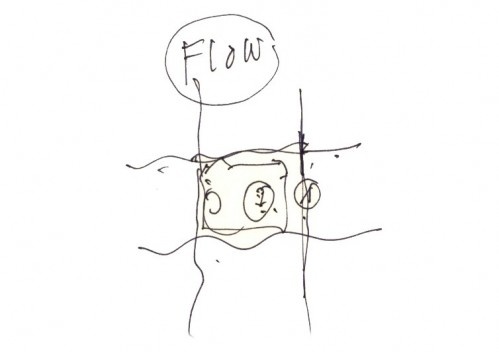
El FLOW SYSTEM: esquema de interconexiones entre células
Manfred Schiedhelm
MS: But there is also something in between the cells. I think that the analogy about the cell is not very good. The first city was around a path. And then, the city goes… but there might be other paths like that and that, and these different areas going in between. And then you say: “oh, that doesn’t work because if you want to have also a connection like that or a connection like that or whether…” I always was very much interested in the FLOW SYSTEM: all connections which flow in a street, you know, like Barcelona. This is the interesting part of the city. That is the second piece “number 2”. That’s “number 1”. Without the system there won’t be “number 2”! And that is something very interesting, I mean, that “economy”, how they influence each other.
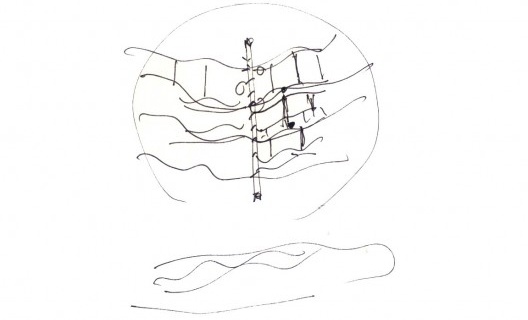
The Bochum competition: the main pedestrian street and the growth principle
Manfred Schiedhelm
JV & XB: Talking more about the cell, in the project of Frankfurt Römerberg, why the measure of 36-37m exactly?
MS: Good question! Do you know Paris? There is a theater which is called Odeon. That’s where the ‘68 revolution was triggered, but anyway. Odeon looks like that. It has an arcade, this is Boulevard Saint-Michel and this is a street and so on. And I lived up there and I walked home. I walked to the office which was near the Seine and I came across this arcade. You know, it’s an arcade that looked very simple. And it so happened that I took my measure tape and it happened to be 3’66m Le Corbusier. And, you should know that this distance might be a good width for walking together with other people. 3’66m is a good measure. That was something very helpful! You can watch it every day. I walked there for two months at the time we worked on the competition . And that distance might be something interesting. But the story goes further, I think.
When we made this Bochum competition, there was a big controversy in the office because there was a hill, a hill-side like that. There was a lake down there and we said there might be a street going down, a pedestrian street with the main activities and so. And then, the institutes and the lecturer house they could be there and the institutes would go further and further away. And then, we asked ourselves: “well, what happens if scientist A goes to scientist B?” So we said: “Ok, we have to have a link”. But then it became very chaotic. When we had finished that we thought, concerning Frankfurt, that it was also a big-big site. I always said that this was a sort of romantic nonsense and also very picturesque. And we said: “we can’t do that!” Then came once Shadrach Woods, he put a millimetric paper on the window. We looked at it: “That’s not so bad!”
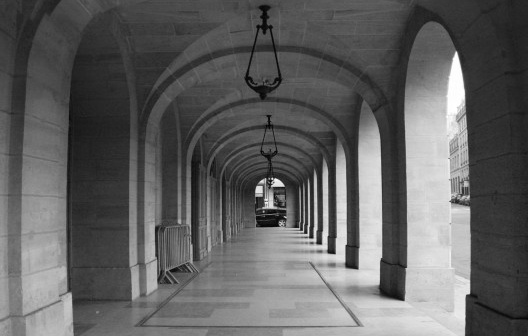
Odeon Teather in Paris
Jordi Viñals y Xavier Bosch
And, at the same time, I made a trip to New York and that influenced me a lot. It was fantastic! If you live there you have two co-ordinates plus the height. It’s absolutely clear to identify where somebody lives: “Broadway, 5th street, 3rd floor”. That’s where you are! You have something in space; you know exactly where you are! And that impressed me a lot! You don’t need to have an address. You just have three numbers. You have definition in space!!
And there is a second fantastic experience I had then. We were about five or four (people). I laid down the grid which was not fitting really well. You have this place: Romerberg. Have you been there? Right! There’s a little church there…Ok, I mean, it was so brutal!! We wouldn’t do that today anymore. But we thought: “Let’s fight everything and break everything!” It was also a rebound against everything which was lovely, and nice and picturesque! And if you look at it critically…ok, it had nice things because there is the boat, and the passages to the boat and all this... But the most important thing for all the people who worked in that, it was that once this was laid down, the grid and the thirty…
JV & XB: …seven…
MS: …six or so…yes, I didn’t remember that…we thought this might be okay because, look, between the 36…. No, it can’t be! 32, 32! It is that one!
JV & XB: 32?
MS: Yes, anyway, it’s going to Le Corbusier, so…
JV & XB: That’s interesting because we have read 36 in some books, 37 in others…
MS: Oh! You have to be very suspicious about what is written. I mean, I can’t believe how much non-sense is written about our work! Unbelievable!! The journalists, they just copy from the other ones and they don’t think anything, they are not in the matters, they have no emotions, they are not art historians! And be aware of art historians as well, they are a dangerous spice…what I wanted to say is once this was laid down and when we had the outskirts of the whole thing, then, we said: “we put the program plus 30% out”. You take the program and you lay it out flat, the whole thing. You say, we have 300m2 and you put it flat, and then you take some pieces out which makes 2 to maximum 3 storeys and you get free spaces in-between. It’s very simple! A simple way of dealing with it! You have the program, a heavy program, terrible!! But then if you say: “ok, I have “x”m2. That’s…” well, with the calculator you can do exactly how much is it…
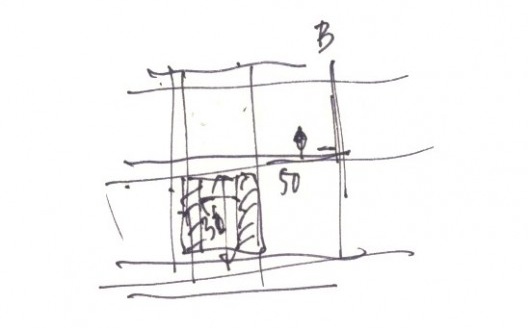
El concepto WEB y el programa
Manfred Schiedhelm
MS: 1024, ok! That’s the surface and you have the program. If the program doesn’t fit, do you have to have another piece on the other side or over there or whatever …but we said: “always the streets have to be free”.
It’s the same experience since we were people from different cultures; there was a Japanese girl, there was an Italian man who worked with Giancarlo de Carlo. And there was an American architect and a German girl…and it was very interesting for me to see how they conceived of space, you know, like you…
JV & XB: …in different ways…
MS: Yes, in different ways, totally! But I was surprised when the Japanese girl came, she had strange ideas, but good ideas which the European background will never have. And this was also a lesson that internationalism would be a tool for urban design anyway.
JV & XB: And there was an atmosphere of cooperation, wasn’t there?
MS: Oh yes! We worked until late at night, always we had coffee together and ate together…it was very nice, a friendly cooperation!
JV & XB: You have said that you wouldn’t do that today, because maybe it was too radical….
MS: Too brutal towards the environment where we did so. But it has nothing to do with that! The concept could be applied and the edges could be done much more smoothly.
JV & XB: About this point, if we compare the Frei Universität and Frankfurt Römerberg, the interesting thing about Frankfurt is that we are in an urban context. This adaptation of the WEB concept in an urban context, do you think it had limitations, doubts, critical points?
MS: I think it’s a question of adaptation, how you adapt the whole thing. It depends on your skills, how you relate, how…like we are talking to each other. This kind of idea has to relate to the old stuff and that has to be solved. We were not interested in this, we said: “now let’s do everything!”. We wanted to break everything! In young ages it is very important to do that, to walk against the old guides and old systems and stuff like that. It’s a kind of liberation!
JV & XB: How long did it take to prepare the project of Frankfurt?
MS: Two months or something like that.
JV & XB: Did you also work with Tolouse-le-Mirail?
MS: Oh, Tolouse was already settled and I was just drawing…how to say that, city plans, you know, the execution plans. That was in another area of the office.
JV & XB: So your first contact with the WEB was with Frankfurt?
MS: Oh yes! Woods and me had long dialogues always and you can’t isolate this in architecture, you know? You have to think about art, music and whatever. Woods and I were very much interested in modern music and modern art. And, of course, in those days there was Jackson Pollock. He was very important and some musicians like Henry Cowell and John Cage also were very influential. And also, if you like to read: James Joyce, Ulysses. I don’t know if it’s translated into Spanish. It’s very difficult to read it in English. But it’s very interesting because it’s also a sort of “mishmash” of ideas. If you get lost one day in a thick book like that, then it’s fantastic! But it’s an obvious influence. I loved the life in the streets of Paris of the 60s which was very peaceful still. And also Le Corbusier was still there. As you have said in the beginning Le Corbusier was there!
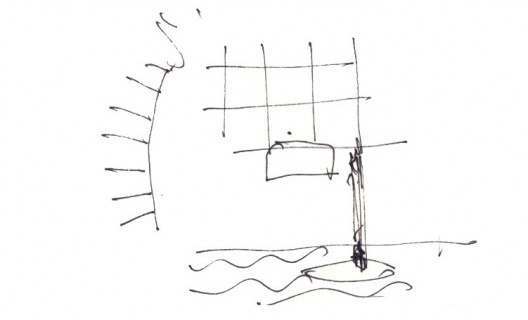
La WEB: la retícula aplicada en Frankfurt-Römerberg
Manfred Schiedhelm



